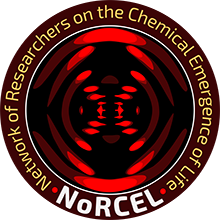The “water paradox” is a crucial problem in the research on the prebiotic chemical evolution towards the emergence of life: It states that although aqueous environments are essential for life, they impede key chemical reactions such as nucleotide polymerisation. In aiming to overcome this paradox various hypotheses have been proposed, including scenarios based on alternative solvents like formamide, condensing agents like cyanamide, high temperatures (~160°C) or approaches based on wet/dry cycles. However, when appraising the prebiotic plausibility of such scenarios general weaknesses appear. Besides the fact that all known life manages the water paradox without needing such proposed conditions, evolutionary conservatism – the principle that evolution builds on existing pathways – indicates that the same physicochemical effects were probably involved in the abiotic origin of biopolymers as now being tapped by life via complex enzymes.
This talk shows that abiotic temporal nanoconfinements of water can serve as natural reactions vessels for prebiotic RNA formation. Evidence is presented for spontaneous, abiotic polymerisation of nucleotides in water. According to the results the reaction is enabled by the rise of anomalous properties of water when being temporarily confined between nanoscale separated particles of geological ubiquity within aqueous suspensions. These findings can solve the water paradox in such a way that nanofluidic effects in aqueous particle suspensions open up an abiotic route to biopolymerisation and polymer stabilisation under chemical and thermodynamic conditions which also exist within the intracellular environment of living cells. The fact that polymerase enzymes also form temporal nanoconfined water clusters inside their active site implies that the same physico-chemical effects are tapped for nucleotide condensation in water both by biochemical pathways and the reported abiotic route.
This indicates that our model is consistent with evolutionary conservatism stretching back to the era of prebiotic chemical evolution. The consistency is further supported by the fact that water is not trapped by nanoconfinements within the polymerase core but can exchange with the surrounding intracellular fluid – a situation which is also prevalent in nanofluidic environments within aqueous particle suspensions. Our experimental finding that under the reported conditions an amino acid catalyses the abiotic polymerisation of nucleotides may give a hint to a nanofluidic origin of cooperation between amino acids and nucleotides evolving to the interdependent synthesis of proteins and nucleic acids in living cells. Abiotic RNA polymerisation in temporal nanoconfined water does not depend on highly specific mineralogical and geological environments: Now as then in the prebiotic world, watery suspensions of micro- and nanoparticles are virtually ubiquitous – they exist, for example, in the form of sediments with pore water, hydrothermal vent fluids containing precipitated inorganic and polyaromatic particles or dispersed aggregates inside water-filled cracks in the crust of the earth and possibly of icy moons such as Enceladus.
Greiner de Herrera, A., Markert, T. & Trixler, F. Temporal nanofluidic confinements induce prebiotic condensation in water. Preprint, DOI: 10.21203/rs.3.rs-163645/v3


